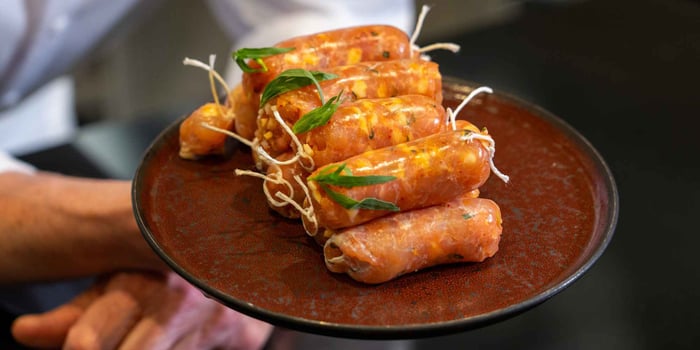Discover the authentic recipe for homemade poultry sausages, created by Chef Christian Segui, Meilleur Ouvrier de France Charcutier-Traiteur and Executive Chef at the EHL Hospitality Business School in Lausanne. With his expert advice and professional tips, you will learn how to make this delicious charcuterie speciality, perfect for your summer barbecues. Follow the step-by-step preparation and cooking instructions to excite your guests’ tastebuds with mouth-watering, perfectly browned sausages.
Recipe for poultry sausages with tarragon
Chef Christian Segui, Meilleur Ouvrier de France Charcutier-Traiteur at the EHL Hospitality Business School in Lausanne, shares with us his own recipe for homemade poultry sausages. Follow his expert advice to make this delicious charcuterie speciality in the comfort of your own home.
Choose your ingredients wisely for better, tastier poultry sausages
For perfect poultry sausages, select top-quality ingredients. Choose fresh products rather than frozen products and go to an artisan butcher, who can provide you with the freshest products as well as casings to make your sausages.
For 8 to 10 people
Sausage meat (to be made the day before):
- 400g of lean pork
- 350g of chicken fillets
- 250g of Colonnata bacon
- 16g of sea salt
- 3g of Espelette pepper
Sausage meat (on the day):
- 50g of shallots
- 15cl of dry white wine
- 2 sprigs of fresh tarragon
Making the sausages:
- Sheep casings 24/26

How to make homemade poultry sausages?
Step 1: sausage meat (to be made the day before)
Cut and dice the meat into 5mm pieces.
Remove leaves and finely chop a sprig of tarragon. Set aside.
Salt the meat with fine salt, Espelette pepper along with the chopped tarragon.
Cover with film and set aside overnight at 3°C.
It is advisable to mix the meat the day before for the next day. This is what we call in the trade 'salting' when making sausages. The curing process allows the flavours to develop and intensify. The salt penetrates the meat, significantly improving its taste.
Step 2: sausage meat (on the day)
Peel and chop the shallots. Place them in a saucepan with the white wine and the second sprig of tarragon, and allow to reduce gently over a low heat.
Remove the sprig of tarragon, allow to cool and set aside.
Mix the shallots with the meat until you obtain a homogeneous mass.
Step 3: making poultry sausages
Rinse the casings in water.
Feed the sausage meat in the sausage machine, and start filling the casing.
How to cook poultry sausages?
There are several methods of cooking poultry sausages: in the pan, on the barbecue or in the oven in the grill position. Here are the tips and cooking times to obtain well-coloured sausages:
- Pan or barbecue: cook the sausages for 10 to 12 minutes, turning them regularly for even cooking and a nice golden colour.
- Oven in grill position: preheat your oven in grill mode and cook the sausages for 10 to 12 minutes, turning them halfway through cooking so that they are nicely browned on each side.
Do not season the sausages during cooking to preserve their natural flavour.
Enjoy your meal!
Discover the chef behind this tasty recipe: Christian Segui
 |
Meilleur Ouvrier de France Charcutier-Traiteur and Executive Chef at the EHL Hospitality Business School in Lausanne. |
Son of a charcutier by trade, Christian Segui inherited his father’s passion for the catering profession at a very early age. He began a cooking apprenticeship at the Golf de Saint-Cyprien with Michel Guillamou, chef of Michel Guérard. Later, he bought the charcuterie of his native village and considerably developed the charcuterie section. In 2011, he obtained the title of Meilleur Ouvrier de France Charcutier-Traiteur then set-off, in 2015, on a new adventure at the EHL Hospitality Business School in Lausanne, as a Master of Practical Arts. There, he took on the role of executive sous-chef and managed a team of 20 people in production. In 2019, he became Executive Chef of EHL, regularly ranked on the podium of the best hospitality schools in the world.
Find other mouth-watering recipes in “Le grand livre de la charcuterie”, Fabien Pairon & Christian Segui, Ducasse Éditions.





